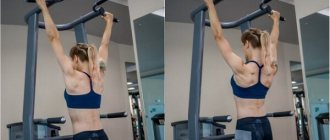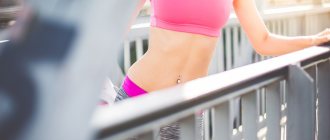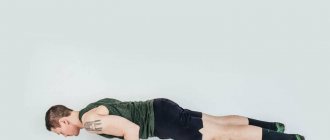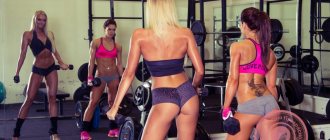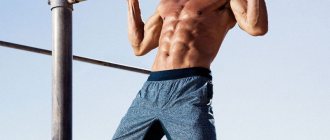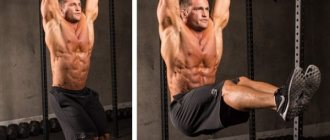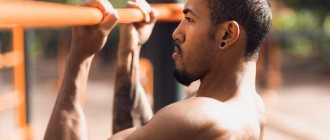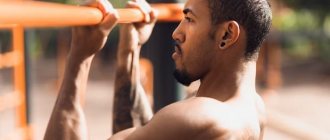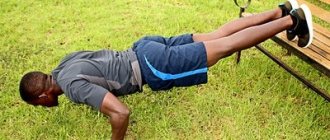Pull-ups are one of the most difficult exercises for beginners. Unlike squats or push-ups, not everyone can do a pull-up the first time. Many don't even know where to start.
Pull-ups are suitable for many people: men, women, teenagers and even children. You can exercise both at home and in the gym, and even on the street.
It is precisely because of its complexity that many teaching schemes for this exercise have been invented. They depend on the general physical preparation of the beginner and personal skills. Some will have to start from the very basics, while others will only need to improve the already developed technique. The main thing is to determine your level correctly.
The benefits of exercising on the horizontal bar
Everyone primarily associates the horizontal bar with pull-ups. Although this trainer has several uses. Even the smallest children can practice on it, performing a regular hang with a direct grip.
This activity relieves stress on the spine and forms correct posture. Hanging on a horizontal bar is necessary for the prevention and treatment of spinal curvatures.
- The most popular exercise - pull-ups strengthens the muscles of the back, shoulder and arms. They are loaded by the body's own weight when it is lifted. Strengthening the back muscle corset helps maintain a straight posture and greater endurance during physical activity.
- More complex complexes, such as inversion lifts, are performed by experienced athletes. They help to more actively develop the muscles of the arms and shoulder area, receiving greater load. Such complexes require not only high power expenditures, but also high concentration, which contributes to its further improvement.
- In addition to the back and arms, the abdominal muscles work while doing pull-ups on the horizontal bar. It tenses to increase the effort, thereby forming a beautiful slender stomach and sides.
Benefits of exercising on the horizontal bar
In bodybuilding, pull-ups with various types of grips and with additional weights are one of the main basic exercises. Primarily for the development of the latissimus dorsi muscles.
However, there are many more muscles involved in movement. In addition to those already mentioned, other back muscles also receive quite a large load - the round, rhomboid and dorsal (lower) part of the trapezius.
Also, pull-ups on the bar involve the arm muscles. It is believed that for beginners there is no better basic movement for pumping up the biceps and forearm than pull-ups on the bar with a reverse grip.
In this case, you have to work with the weight of the entire body (for example, 70 kg), which is always much more than in any isolated exercise.
In addition to the back and arms, the posterior bundle of the deltoid muscle is also included in the work. Well, the abs and lumbar muscles receive indirect load, acting as stabilizers that help keep the body in an upright position.
In addition, pull-ups on the bar contribute to an increased release of testosterone into the general bloodstream.
This hormone is responsible not only for libido and the development of primary sexual characteristics in men, but also has anabolic properties . Testosterone directly affects the rate of muscle mass and strength growth. The more there is, the faster this happens.
By the way, everyone’s favorite lat pull-downs, which beginners consider a good alternative to pull-ups, stimulate testosterone production much less. Therefore, the result in terms of muscle growth from them is not so pronounced. Mass gain will be better when training on the horizontal bar.
Even professional bodybuilders, with a body weight of 130-150 kg, always use pull-ups in their back programs.
But despite its advantages, pull-ups on the horizontal bar are only one of many “working” strength exercises. It has no effect on the growth of the chest and triceps and certainly will not help pump up the muscles of the legs.
Therefore, if your goal is to gain muscle mass throughout the body, you should not rely only on the bar.
In your training program, be sure to include movements for the legs, chest, and other smaller muscle groups.
This is the only way you will form a harmoniously built, athletic figure.
Where to begin?
Methodology for starting to do pull-ups on the horizontal bar:
- You need to start by determining your level of physical fitness and previously acquired skills. You can start exercising both at home and in the gym.
- Most often, the question of training is asked by beginners who absolutely do not know how to perform this exercise. Therefore, it is worth considering the learning process from the initial level. At this stage, you need to prepare your body for a certain type of physical activity, in this case, doing pull-ups on the horizontal bar.
- To make the effort to lift the body to the bar, it is necessary to strengthen the muscles involved in this process. This will make learning go much faster. The easiest way to do this is by practicing push-ups. During them, similar muscle groups work, but it is much easier to perform. This way your shoulders and back will be trained.
- The seated lat pull-down exercise will be more effective. It simulates the work of muscles during pull-ups as much as possible and allows you not only to train, but also to understand the processes occurring in the body during the exercise.
What muscles work when doing pull-ups on the bar?
You can perform the exercise with different grips, thereby shifting the load to one muscle group. For example, when performing an exercise with a reverse grip shoulder-width apart, the main load falls on the biceps. However, pull-ups on the horizontal bar are a basic exercise; no matter what grip the athlete performs it with, many muscle groups will still be involved in the work.
When performing pull-ups on a horizontal bar, the following muscles are used:
- the latissimus dorsi muscles receive maximum load when performing the exercise with a wide grip;
- the trapezius muscles are used approximately equally when performing pull-ups with any grip;
- biceps , as mentioned earlier, are perfectly pumped with a reverse grip, shoulder-width apart or narrower;
- the posterior bundle of deltoid muscles is actively involved in pulling up behind the head with a wide grip;
- the abs and obliques serve as stabilizers, as in most other exercises performed in the gym;
- the forearms are responsible for grip strength (if you have grip problems, it is recommended to use straps).
As you can see, a huge array of muscles is involved in performing pull-ups on the bar, which makes the exercise irreplaceable and extremely effective.
Read also: How to pump up your back
How to learn to do pull-ups?
- In order to learn this exercise, you need to choose the most suitable technique for yourself. Exercises should gradually become more difficult as you get used to them. Continuity and systematicity of classes is important. As soon as you manage to pull yourself up for the first time on your own, you must definitely consolidate the acquired skill.
- Along with performing the exercises, it is important to learn the correct grip, simple hanging on the horizontal bar and precise execution technique.
- At first it will be difficult to do more than 1-2 lifts at a time. Therefore, after them, you need to continue to work on the established program, complicating it and without stopping trying to lift the body.
- Over time, full pull-ups will replace simple preparatory exercises, and all that remains is to increase the number of exercises and approaches. With the onset of this moment, you need to carefully monitor the technique and constantly practice it.
In addition to exercise machines, you need to stretch your back muscles to better feel their work. It is performed before training as a warm-up. During training, you should alternate approaches to block pulls and direct pull-ups using any initial technique.
The right technique for a beginner from scratch
For beginners, there are several ways to start training:
Blocks
Blocks and reverse pull-ups help to train at the initial stage, when all skills are reduced to zero.
In these exercises, the athlete pushes off from a support and, bending his arms at the elbow to an angle of 45 or 90 degrees, fixes his position on the horizontal bar.
You need to hold this position for as long as possible, but at least 10 seconds in each position.
Reverse pull-ups
The reverse pull-up exercise can be a full-fledged training complex. It consists of a group of different blocks.
Starting position – elbow angle 45 degrees. After hanging in it for the set time, the athlete smoothly extends his arms to a right angle and is again fixed for a while, after which the angle increases to 120 degrees.
During exercise, the strength will gradually increase, and you can, having lowered yourself to the highest bend angle, try to rise, also fixing the blocks. First 90, then at the top point - 45 degrees. The final stage is the transition from short bends up to a certain block to a full pull-up without stopping.
Pushing off with one leg from the support
Pushing off with one leg from the support is a less effective method. It is used rather as a complement to other techniques. You can push to fix the block or start training short rises. In this method, a stool or step is used for support, and when exercising in a gym, it can be a wall bars.
Pull-ups with harness
In the latter case, a regular medical tourniquet or elastic band is used. At one end it is tied to the crossbar, and at the other end a loop is made under the buttocks.
She adjusts herself so that the tourniquet is pulled back, but at the same time provides a little support for the push. This method of initial training is suitable for those who already have slightly developed back muscles.
You can move on to them from the initial stages with gradual intensification of training. This exercise will be the last one before moving on to pure pull-ups, without any assistance.
When performing any exercises on the horizontal bar, you must not jump off it. This will create a shock load on the knee joints, which will lead to further damage. Incorrect standing on your feet when jumping can result in a dislocation of the knee joint or ankle.
Also, you should not make sharp jerks upward, trying to bend your elbows and suddenly throw your body from the top point of the lift. Such actions can damage muscle tissue and ligaments. The most common injuries on the horizontal bar are sprains and tears.
Pull-up technique for girls from scratch
Despite its apparent simplicity, pull-ups are a very complex exercise in terms of technique. At the initial stage, it is advisable to make the training as easy as possible and use similar exercises.
Blocks
The lat pulldown has become popular because it is much lighter and simpler than pull-ups. However, it cannot completely replace them and is suitable as a preparatory exercise. Performed in a sitting position by pulling the bar to the upper chest. The body must be motionless.
Pushing off with one leg from the support
Imitation of pulling up by pushing or using two legs from any support is an absolutely useless element of the training. The reasons for this will be discussed in the section on learning to do pull-ups.
Reverse pull-ups
Reverse grip pull-ups are used mainly to pump up the biceps. They are much easier to carry out than classic ones.
For this reason they are used more widely. They are quite suitable for preparatory work for performing the main exercise.
Pull-ups with harness
To facilitate the exercise at the initial stage, you can use a special rubber band, which is made in the form of a loop. You can insert your knee into it. If it is more convenient to insert both at once, then you need outside help to do this.
The length of the tourniquet is selected individually so that it ensures full straightening of the arms when lowering.
Using a harness allows you to simplify the task and perform more pull-ups than when working with your natural weight.
But it also has a number of disadvantages:
- If your hands are taken off the bar, there is a danger of your feet getting tangled in the tourniquet.
- If the harness breaks or the leg slips out of the loop, a jerking load occurs on the arms.
- Does not allow you to learn the correct pull-up technique.
Don't miss the most popular article in the section: Body drying for girls. Training program, detailed nutrition menu for the month by day.
Difficulties for beginners
Beginning athletes face difficulties on the way to performing pull-ups correctly.
Their reasons are:
- Excess weight. Excess weight not only creates additional stress, but also partially hinders the functioning of the joints. Having this negative factor and not having played sports before, you should refuse to do pull-ups. This exercise requires good physical fitness. Therefore, you will have to first go on a diet and perform easier complexes that promote weight loss.
- Physical weakness. Even after normalizing your weight, you cannot immediately start doing lifts on the bar. To do this, you need to gain good physical health, develop muscles and tone them. Not only muscle strength must be developed, but also their endurance. It accumulates through constant repetitions of initial techniques, with a gradual increase in the number of lifts.
- Weak accessory muscles. Accessory muscles are intensively involved in lifting the body. Their strength will influence the quality and effectiveness of the workout. Therefore, when preparing for training, you need to pay attention not only to pumping up the muscles of the back, shoulders and arms, but also to the physical preparation of the body as a whole.
- Unpracticed or incorrect execution technique. Incorrect technique will interfere with learning. The exercise will be much more difficult to perform or, on the contrary, easier, but it will not have the correct effect on the muscles. In addition, violation of technique leads to accidental injuries, sprains and ligament tears.
What muscles are used when doing a pull-up?
During pull-ups on the horizontal bar, a large number of different muscle groups are involved. They are divided into main and auxiliary.
The main ones include:
- Forearms.
- Shoulders.
- Biceps.
- Triceps.
- Trapezoid.
- Latissimus dorsi muscles.
- Press.
They are responsible for efforts when bending and extending the arms, lifting the body and maintaining it in tension.
Accessory muscles:
- Radiation.
- Deltoid.
- Breasts.
They do not have a direct impact on the creation of movements performed when pulling up on the horizontal bar. But when they tense, they create a rigid frame for the body, which facilitates easier and more precise movements.
Ways to do pull-ups
By performing this exercise, various muscle groups are worked out. Loads well:
- dorsal backs;
- biceps;
- shoulder muscles;
- trapezoidal;
- paired round.
Muscles involved during a pull-up. They are marked with colors in the figure. Pull-ups allow you to work several muscle groups at the same time
There are several ways to perform the exercise - pull-ups, each of which distributes the load on the muscles differently. Let's look into this issue.
The main ones:
- If you do pull-ups with your hands in a medium straight grip, the following muscles are affected: the back, shoulders, and biceps. Hands in this case should be shoulder-width apart from each other, palms turned away from the face;
Correct technique is the key to the effectiveness of the exercise. Medium straight grip - excellent pumping of the muscles of the arms, back, shoulders
We also recommend studying this topic:
How can you do pull-ups on a horizontal bar? Main types and technique of execution
10302 0 0
- By doing pull-ups with a medium reverse grip, the athlete works the biceps, as well as the latissimus dorsi muscles. Hands should be positioned similarly to the previous option, but the palms are turned towards the face;
Performing pull-ups with a medium reverse grip. Correct technique is the key to good results
- wide grip to the chest. This embodiment affects the trapezius, as well as the paired circular muscles and the upper zone of the latissimus dorsi muscles;
Wide grip to the chest - technique for performing the exercise. If you follow all the subtleties, you can achieve the desired result.
- with a wide grip on the head. The best exercise for working the trapezius and paired teres muscles. In addition, the middle as well as the upper zone of the latissimus muscles are indirectly involved;
Performing pull-ups with a wide head grip. Excellent work of the back muscles
- A narrow and straight grip allows you to work the shoulder muscles, as well as the serratus muscles. In addition, the lower zone of the latissimus dorsi muscles is involved;
Pull-ups with a narrow straight grip. The closer the hands are to each other, the greater the load on the muscles
- narrow reverse grip. Such pull-ups force the biceps to work, as well as the lower zone of the latissimus muscles;
Pull-ups with a narrow reverse grip pump up the biceps. The exercise gives a good effect
- Performing the exercise with a neutral grip is aimed at working the brachialis and serratus muscles. In addition, the lower zone of the lats is involved in the work.
Neutral grip pull-ups. Correct technique and toned shoulder muscles
Important! In addition to the muscles involved, changing the grip width can change the load. The narrower it is, the larger it is.
Readers found these materials useful:
- Sports compression clothing CW-X - the choice of athletes
- Modern technologies in the production of medical clothing Incrediwear
Choosing workout clothes
Clothing for training must be comfortable, consisting of natural or special synthetic breathable material. The uniform should not hinder the athlete’s movements, rise up uncomfortably or dig into the body, distracting from training. These could be T-shirts or tank tops, sweatpants, shorts or leggings.
- Girls need to choose special sports underwear. It correctly supports the characteristics of the female figure during training and does not create additional discomfort due to the pleasant material, the absence of hard inserts and protruding seams.
- Shoes must be special sports shoes, chosen exactly in size. A small one will put pressure on and deform the leg, interfering with the correct technique for doing the exercises. A large one creates a risk of leg injury due to poor foot fixation.
- Socks must be worn under shoes. They should not be made of unpleasant synthetic material. A properly selected sock wicks away moisture well and does not interfere with foot ventilation, preventing the greenhouse effect.
All equipment is selected based on one main rule: performing exercises should be as comfortable as possible. Physical activity itself requires full concentration. Therefore, the athlete should not be distracted by irritating factors such as uncomfortable clothing.
Warm-up
- Warm-up before training begins with a warm-up. Running, jumping rope and any other active movements will raise body temperature and activate all muscles.
- During normal movements, the joints work in a moderate mode and sometimes stagnate. Active physical activities place a lot of stress on them, so you need to work every joint to “wake them up.” For this part of the warm-up, rotational movements of each node are performed.
- The exercises are performed starting from the upper body and gradually descending below. Before doing pull-ups, warm up your hands, elbows and shoulders especially carefully, as they take on most of the load.
- The warm-up ends with stretching. It increases the elasticity of muscles, allowing them to work much more efficiently and not hurt after training.
Particular attention should be paid to the muscles of the arms and back. The entire warm-up should take about 15 minutes. 5 minutes for each block of exercises.
Exercises on simulators for quick results in pull-ups
There is also a special simulator for learning pull-ups. It's called a gravitron . It represents a platform for the athlete to position himself and a horizontal bar for pulling himself up.
A counterweight is attached to the crossbar, which simulates the force from lifting the body. By exercising on such a machine, you can adjust the load, moving to a new level.
In addition, it allows you to examine and understand in more detail the sequence of work of all muscle groups during pull-ups.
- Exercises on special simulators will develop muscles and prepare them for doing pull-ups.
- The best machines for training your upper body are the pull-down and rowing machines.
- They challenge your arms and back, building muscle mass and building endurance through long workouts.
- You need to train regularly at the preparatory stage, performing at least three sets of 10–15 repetitions 2–3 times a week.
Tips for pull-ups on the horizontal bar
The tips described below are mostly true for beginners, but experienced athletes can also find useful information.
Correct technique is key!
- Constantly work on improving your technique, especially in the early stages of training.
Without proper execution of pull-ups, you will not see any results.
We repeat once again, do not chase results! Perform each repetition cleanly and under control. - Train pull-ups no more than 3 times a week.
- Even four or five workouts a week can drive an athlete into overtraining and take him out of the training process for a long time. Two to three workouts per week will be enough (in the beginning). Experienced athletes can exercise much more often.
- Don't forget about recovery.
- Healthy sleep and proper nutrition are a must.
The result will not increase continuously if recovery is neglected. Be less nervous, eat and sleep more, then progress is inevitable. If necessary, you can use sports nutrition, but don’t get carried away.
Straps
Experienced athletes can use straps in two cases. We have already discussed the first, it is associated with better development of the back. The second involves the use of straps when working with a lot of additional weight. There are athletes who do pull-ups with a weight of 60 and even 70 kilograms, so the second case is true for them.
A beginner should not use straps to strengthen his grip and build muscle on his forearms.
Deal with the problems that are preventing you from doing a lot of pull-ups
If you weigh about a hundred kilograms or more, and this is not muscle mass, then you will have to forget about a good result in pull-ups until you lose weight.
Excess weight is one of the main reasons for the inability to do at least one pull-up.
Don't jump off the horizontal bar
After completing the next approach, many guys fly down like a sack of potatoes, having previously swung strongly. This is strictly prohibited.
Why? The moment your feet touch the ground, the load on your joints is enormous. The spine and knee joints suffer the most.
Additional weight
After some period of time, you will have to buy a belt for additional weight.
Otherwise, only endurance will be trained, and strength and muscles will remain at the same level due to lack of load.
Training programs for different levels
Different levels of physical fitness require individual programs for muscle development and pull-up training. Physical condition depends on several factors. It is influenced by a person’s gender, age, build, and lifestyle.
Zero level
For those starting from scratch, it is important not to overdo it and not try to follow the tables offered in large quantities on the Internet. During the first training sessions, you need to understand the essence of the exercise and master the correct technique.
- The best way to do this is with a simulator , but in its absence you need to rise into the block, pushing off from the support, and slowly lower, observing the work of the muscles.
- To practice lifting, you need to use a tourniquet or the help of a trainer. Such exercises should be performed in several approaches with short rest intervals. 10 repetitions 3 times. These exercises should be given 2-3 workouts.
- In the second week of training, you need to pay attention to muscle development in order to move on to full exercise. To do this, each approach should alternate with lat pulldowns. This complex is performed the same 3 times for 10 repetitions.
- As soon as you begin to be able to lift yourself independently without additional support, you need to gradually increase them. The training volume remains the same. Preparatory exercises are gradually being replaced by ordinary ones.
For men
The male part of the population naturally has a more developed muscular frame and many can initially do 1-2 pull-ups. If you don’t even have such a skill, then you need to lift with a push from the support and slowly lower.
- In the first approach, lowering and lifting are performed with the block fixed at each point for 5–10 seconds, the remaining two are done smoothly, without stopping. Each set contains 10–15 repetitions.
- As soon as pull-ups become independent, you need to add exercises on simulators to increase endurance. Perform as many clean pull-ups as possible and move on to the machine. For example, do 2-3 pull-ups and perform 10 reps on a pulley row or rowing machine. The number of pull-ups for the entire workout should be at least 10 and gradually increase.
- After the exercise becomes easy to perform 10 times , training on training complexes can be eliminated or reduced to a minimum. Now you can focus on the number of lifts and approaches, working on the execution technique.
For girls
Girls most often have a weak muscle base, and pull-ups are not easy for them without difficulty and effort.
- Before you start the training itself for the first week, you need to prepare your body. To do this, perform lat pulldowns 10 times in three approaches. Each of them should alternate with an elliptical, treadmill or any other cardio machine.
- A simpler option is training on a special installation. The counterweight exercise machine is great for beginner girls. It immediately imitates pull-ups, while facilitating the moment of lifting the body. You need to do 10–15 lifts, 3 sets.
- In the second week, you can start doing pull-ups with a push from a support or with a tourniquet. You need to perform 10 repetitions 3 times. Strength training is reduced to one approach, and cardio is excluded or added at will as a warm-up and cool-down.
- In the third week, independent pull-ups should be increased and added until other exercises are completely replaced. It is much more difficult for girls to learn how to climb on the horizontal bar. Therefore, you can start switching to regular pull-ups not from the third, but from the fourth week.
For children
Children do not have sufficient physical fitness to perform such exercises, although they are more dexterous and learn quickly.
- Their preparatory stage will take longer - about three weeks. During this time, you need to perform push-ups from your knees, plank, hyperextension, press, hanging on the horizontal bar and monkey bars. Each exercise should be given up to 10 repetitions of 1 approach. Perform 2-3 workouts per week.
- In the third week, you can start learning pull-ups. To understand the principle of the exercise, children can do pull-ups not from a hanging position, but with their feet against the wall. This way he can understand the technique and try his hand at it.
- By the end of the month you should start doing regular pull-ups. Since a child, boy or girl, will most likely study not independently, but with an adult, the easiest way to learn is with help.
- The child needs to be lifted, holding him by the waist and lower back, not allowing him to lean heavily on his arms. Pull-ups should strain his arms at least a little and make him feel the weight of his own body. Gradually, assistance should be reduced until complete independence. Perform 1-2 sets of exercises each, no more than 10 times.
For full
- For overweight people, having excess weight will make it very difficult to perform lifts on the bar. Therefore, when drawing up a training program, you need to devote the first month to fat-burning training and diet, since without losing weight you cannot achieve a good result.
- As soon as the first weight loss is noticeable, you can gradually add sets of pull-ups with help. You need to start with 1 approach of 10 times, gradually increasing their number. You can begin constant independent pull-ups if you confidently perform at least 10 lifts.
Training program on the horizontal bar
For those who have learned to do pull-ups well and many times, special programs are drawn up to develop this skill. To do this, set a goal, for example, to do 50 pull-ups. First, determine the number of pull-ups you are performing at the moment.
On average this is 5–10 times. Then the training program will begin with 5-6 lifts. It is calculated by day.
The numbers indicate the number of pull-ups in one approach:
- First workout: 4, 6, 5, 5, 6. Total 26 times.
- Second workout: 4, 7, 5, 6, 7. Total 29 times.
- Third workout: 5, 8, 5, 7, 8. A total of 32 times.
- Fourth workout: 6, 9, 6, 7, 9. A total of 37 times.
- Fifth workout: 6, 10, 8, 8, 10. A total of 42 times.
- Sixth workout: 8, 12, 8, 10, 12. A total of 50 times.
Rest between sets should be 1-2 minutes, and between workouts 1 day. After the first three workouts, a break of 2 days is taken.
Pull-up chart for beginners
Lewis Armstrong Pull-Ups
The training scheme is based on the use of different grip widths to train a variety of muscle groups, increase their mass and increase strength.
MONDAY – you need to do 5 sets of pull-ups as many times as possible, don’t be discouraged if you only do 5-7 pull-ups in each set, you’re on the right track. Rest between sets for 1.5 minutes, pull yourself up correctly, do not deceive yourself and do not swing your torso.
TUESDAY – Perform pyramid pull-ups. Perform 1 set of pull-ups the maximum number of times, rest for 1 minute, then 2 sets also for the maximum number of times, rest again for 60 seconds
Then in the 3rd approach, do as many pull-ups as you can for so many seconds and rest, multiplying the number by 10. For example, in the 3rd approach you did 8 pull-ups, rest for 80 seconds, in the 4th approach you did 6 pull-ups, rest for 60 seconds and so on until you reach the approach in which You can do only 2 repetitions.
WEDNESDAY - Goal to perform 9 sets of maximum pull-ups, but with different grips. 3 approaches – wide, 3 – medium and 3 – narrow.
THURSDAY is probably the busiest day, depending on who you are. You need to do the maximum number of pull-ups, 5 will be good, but 17 will be excellent, as long as you can do just 1 pull-up, rest between sets for 60 seconds.
Every 3rd approach, change the grip to your liking, wide, medium or narrow.
FRIDAY – analyze the previous 4 days, choose the most difficult day, this hellish day should be repeated.
This training scheme will exhaust you not only physically, but also psychologically, it is still difficult to implement, but the result is worth it - a beautiful athletic back, graceful posture and power, good luck!
